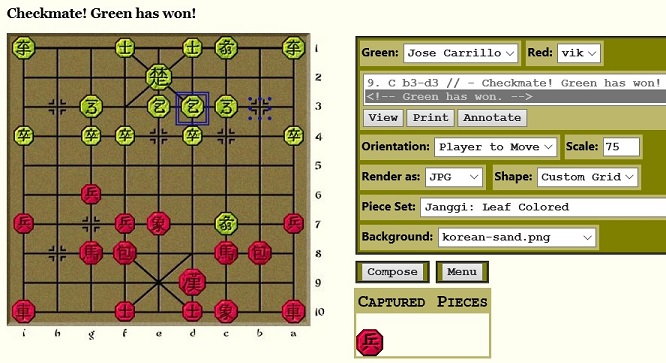Comments/Ratings for a Single Item
I have come across different interpretations of the facing generals rule. The one I've encoded is described on the Wikipedia Janggi page as, 'If the generals come to face each other across the board and the player to move does not move away this is bitjang, a draw.'
In The Encyclopedia of Chess Variants, David Pritchard describes the rule along similar lines. He says, 'The rule concerning facing generals (forbidden in xiangqi) is ill-defined. In theory, the player who in piece terms is materially weaker may face generals, directly or as the result of a capture, forcing the second player to avoid the confrontation or accept a draw.'
In choosing between these, I decided it was expedient to ignore differences in material and go with the first interpretation.
The rule you mentioned is given on our page for the game, but it is not mentioned by Pritchard, whom I do consider to be a fairly authoritative source. It is also mentioned on the Wikipedia page and on the page for the DOS program Jangki. The latter mentions that it has been fact-checked by a Korean player. In all, I think the rule I already coded and the one you mentioned fit together, and they may be used together.
Putting these two rules together, I get this. When any player moves his general to face his opponent's general, he forfeits the ability to win. When one player has already done this, and the other player does it too, the game ends in a draw. This allows the first player to 'check' the second player's general with his, except that the threat is stalemate, not checkmate, meaning that it is not really check. So long as the second player breaks off any facing of generals and lets the game continue, any checkmate by the first player counts as a stalemate.
The rules I found states something such as a player that causes the facing of generals can typically do this as a last resort (I am new to this and can't answer why). However, this player gives up his/her right to win the game, being able to draw at best. I did a little research and I am sure you can find the same thing if you google it, as I did. Not sure if it is correct. Question: The swap function has been banned in the preset I am using. How would you go about modifying the start positions of the elephants and horses before play, as allowed in the rules?
I just benefited from what I believe is a bug in the implementation of the Game Courier preset for Janggi, as Game Courier gave me a win in a position which I believe is not checkmate.
http://play.chessvariants.com/pbm/play.php?game=Janggi&log=vik-cvgameroom-2016-211-785

Thanks for reporting this. I fixed the bug, reverted your log to the backup, removed your log from the FinishedGames table, and incidentally added support (or better support) for displaying legal moves in Janggi and Xiang Qi. The bug was in the built-in checkhop function, which worked well for actual moves and for potential captures (which are all Xiang Qi has to deal with) but not for potential non-capturing moves. You can go ahead and repeat your move now.
Can anyone verify for me that the preset for Korean Chess on Game Courier does not use komi rules (that is, take into account total piece values per side to decide who would win a game that is otherwise unwinnable for either side)?
Looking at the rules page for Korean Chess, it seems komi rules are only used for official Korean Chess tournaments (wikipedia notes this even more explicitly).
I am ahead by a very large amount of material in terms of piece values in an endgame in one game (useless for winning without komi rules, in this particular case, it seems). Besides this being a bit of a waste, and a shame for the game of Korean Chess itself (i.e. without the use of komi rules), what concerns me also is there seems no way to guarantee properly ending the game without agreeing to a draw (e.g. no 50 move rule, unless I forgot it).
7 comments displayed
Permalink to the exact comments currently displayed.
